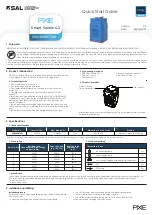
1118
Configuring OSPF and OSPFv3
Flood Blocking
OSPF is a link state routing protocol. Routers describe their local
environment in Link State Advertisements (LSAs), which are distributed
throughout an area or OSPF domain. Through this process, each router learns
enough information to compute a set of routes consistent with the routes
computed by all other routers.
Normally, OSPF floods an LSA on all interfaces within the LSA's flooding
scope. Flooding ensures that all routers receive all LSAs. A router normally
receives a duplicate copy of each LSA once on each interface in the LSA's
flooding scope. The duplicate deliveries make OSPF LSA distribution robust,
but in highly interconnected networks, can cause a lot of buffer and CPU
usage. Buffer and CPU use can be reduced by selectively blocking LSA
flooding on some interfaces, while ensuring that LSAs are flooded on enough
interfaces to guarantee delivery of all LSAs to all routers. When enabling
flood blocking, the network administrator must ensure there is sufficient LSA
flooding even when there are router and link failures.
This feature enables a network administrator to disable LSA flooding on an
interface. Flood blocking only affects flooding of LSAs with area or AS (i.e.,
domain-wide) scope. Such LSAs are expected to be flooded to neighbors on
other, unblocked interfaces, and eventually reach neighbors on blocked
interfaces. An LSA with interface flooding scope cannot be blocked; there is
no other way for interface-scope LSAs to reach neighbors on the blocked
interface. Allowing interface-scope LSAs on blocked interfaces allows graceful
restart to work, even if the restarting router has neighbors on flood blocked
interfaces.
When an interface is blocked, LSAs with area or AS scope are not sent to any
neighbor on that interface. When flood blocking is enabled, OSPF does not
advertise any LSAs with area or AS scope in its database description packets
sent to neighbors on a blocked interface. When OSPF receives an LSA from a
neighbor and the local database copy is newer than the received LSA, OSPF
normally sends the newer LSA directly to the neighbor. If the neighbor is on a
blocked interface, OSPF neither acknowledges the LSA nor sends the newer
LSA. Instead, OSPF expects that the neighbor will receive the newer LSA
indirectly.
Flooding is enabled by default.
Summary of Contents for N2000 Series
Page 50: ...50 Contents ...
Page 54: ...54 Introduction ...
Page 134: ...134 Using Dell OpenManage Switch Administrator ...
Page 168: ...168 Setting Basic Network Information ...
Page 206: ...206 Managing a Switch Stack ...
Page 242: ...242 Configuring Authentication Authorization and Accounting ...
Page 318: ...318 Managing General System Settings Figure 12 24 Verify MOTD ...
Page 322: ...322 Managing General System Settings ...
Page 358: ...358 Configuring SNMP ...
Page 388: ...388 Managing Images and Files ...
Page 415: ...Monitoring Switch Traffic 415 Figure 16 2 sFlow Agent Summary ...
Page 451: ...Monitoring Switch Traffic 451 5 On the Capture Options dialog click Manage Interfaces ...
Page 458: ...458 Monitoring Switch Traffic ...
Page 488: ...488 Configuring Port Characteristics Figure 18 3 Copy Port Settings 8 Click Apply ...
Page 502: ...502 Configuring Port Characteristics ...
Page 567: ...Configuring Port and System Security 567 Figure 19 38 Captive Portal Client Status ...
Page 674: ...674 Configuring VLANs Figure 21 17 GVRP Port Parameters Table ...
Page 680: ...680 Configuring VLANs Figure 21 24 Double VLAN Port Parameter Table ...
Page 714: ...714 Configuring VLANs ...
Page 737: ...Configuring the Spanning Tree Protocol 737 Figure 22 9 Spanning Tree Global Settings ...
Page 760: ...760 Configuring the Spanning Tree Protocol ...
Page 786: ...786 Discovering Network Devices ...
Page 793: ...Configuring Port Based Traffic Control 793 Figure 24 3 Storm Control 5 Click Apply ...
Page 878: ...878 Configuring Connectivity Fault Management ...
Page 899: ...Snooping and Inspecting Traffic 899 Figure 27 17 DAI Interface Configuration Summary ...
Page 903: ...Snooping and Inspecting Traffic 903 Figure 27 24 Dynamic ARP Inspection Statistics ...
Page 924: ...924 Configuring Link Aggregation Figure 28 7 LAG Hash Summary ...
Page 982: ...982 Configuring Link Aggregation ...
Page 1062: ...1062 Configuring DHCP Server and Relay Settings ...
Page 1096: ...1096 Configuring L2 and L3 Relay Features Figure 34 3 DHCP Relay Interface Summary ...
Page 1200: ...1200 Configuring OSPF and OSPFv3 ...
Page 1216: ...1216 Configuring RIP ...
Page 1240: ...1240 Configuring VRRP ...
Page 1291: ...Configuring Differentiated Services 1291 Figure 40 5 DiffServ Class Criteria ...
Page 1336: ...1336 Configuring Auto VoIP ...
Page 1367: ...Managing IPv4 and IPv6 Multicast 1367 Figure 43 20 IGMP Cache Information ...
Page 1422: ...1422 Managing IPv4 and IPv6 Multicast ...
Page 1440: ...1440 System Process Definitions ...
Page 1460: ...Index 1460 ...
















































